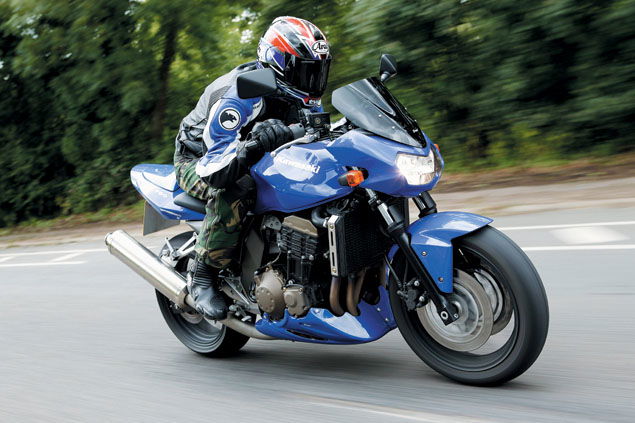2005 GSX-R1000 K5 review
The very thorough Tim Dickson puts the mighty 2005 GSX-R1000 K5 through a year-long review. What's it like to live with?


Right about now, the long-term test bikes turn up. Some people have had theirs for a while, but the 2005 GSX-R1000 K5 was worth waiting for. I was asking, Suzuki were offering, it was a match made in heaven.
Urry even delivered it to my desk. A brand new, zero-mile GSX-R and a sunny Monday afternoon. What would you do? Exactly, sod work, I went to my sister's for a cup of tea. She lives 200 miles away. It needed its first service by the end of Tuesday.
July 2005
I've done lots of miles on 1000cc sports bikes in general and GSX-R1000s in particular on road tests at home and abroad, track days and even a couple of endurance races, but I've never actually owned one.
Borrowing a GSX-R from a manufacturer for a couple of weeks' testing (if you're lucky) is very different to waking up every single morning, come rain or shine, knowing there's one sat in the garage waiting to take you to work, or parked outside the office ready to get you home again. Settling into long-term ownership of a new bike takes a different mindset; everything about the GSX-R1000 that jumped out and grabbed me on our recent 1000cc sportsbike test down to Spain is still there, but the creeping realisation of what a bike is actually like to live with day-to-day can only come from living with a bike day-to-day. So what do I know?

The fuel range is good - up to 150 miles to a tank and 41mpg average - but the trip select button is a bit fiddly to use when riding. It sounds 'kin awesome but the paint on the back of the tank was wearing away by the end of the third day. It's stupidly, unnecessarily fast, but hard to feed power in smoothly from a closed or neutral throttle without lurching forward. It's the most motorcycle you can possibly get in such a compact package, but every time I ride it my licence hangs by a thread.
The biggest concern is my own self restraint. As Spider-Man's uncle once said, "with great power comes great responsibility", and never has that been more true than when riding a GSX-R1000. Using it in everyday traffic is, I imagine, akin to wandering around a busy shopping centre with a loaded machine gun. You have in your hands the capability to cause a huge amount of damage and get into very serious trouble; only knowing it's wrong stops me from doing it. A fraction of a degree's throttle turn too much can have you so far the wrong side of a speed limit so quickly that a monastic level of self control is needed to stay within sight of the right side of the law. I've been banned in the past so know what it's like to be off the road for six months, and that's exactly what I need to keep my right wrist in check.
Given much of the above, there's very little I plan on doing to the Suzuki. I don't need more power, I certainly don't want it to make any more noise, but I could do with a slightly taller screen. Less meddling, more riding.
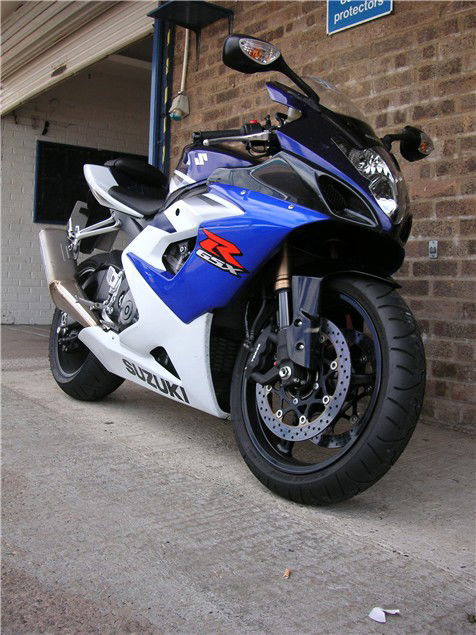
October 2005
Been busy in the last couple of months so let's get on. Exhaust and fuelling first, so off to Dynojet UK to get a Power Commander fitted and try a couple of exhaust options. The first runs were to get a baseline power curve, then Martin fitted the Power Commander III and mapped it to suit the otherwise standard bike. Next up we fitted Yoshimura's very trick Tri Oval can with removable baffle and built-in SET exhaust valve - the valve is part of the can's link pipe on the K5, so fit any other aftermarket can and you'll lose its benefits. £699, which ain't cheap but it's badged as an 'official' Suzuki part so see your local dealer. Baffle in and fuelling mapped there were small gains at 4 and 6000rpm, but a 4bhp loss at the top end. Baffle out it gained everywhere, particularly between 6 and 8000, with a crisper response through the range and an extra 3.5bhp at the top end. But it made one hell of a lot of noise though, and I'm not into that.
With the flyweight Akrapovic Race Conical system on (£934, Performance Parts Ltd, (01788) 869100), baffle or not it lost out at 4000rpm thanks to the lack of SET valve. Baffle in, the Akra is a match for the mapped but otherwise standard motor from 6-11,000rpm, then gains a couple of bhp at the top with the motor feeling crisper and freer-revving. Baffle out it's ahead from 5000rpm to the limiter, making nearly 10bhp more at the top with a healthy 5bhp boost across the midrange. Nice to have, but the noise ain't for me.
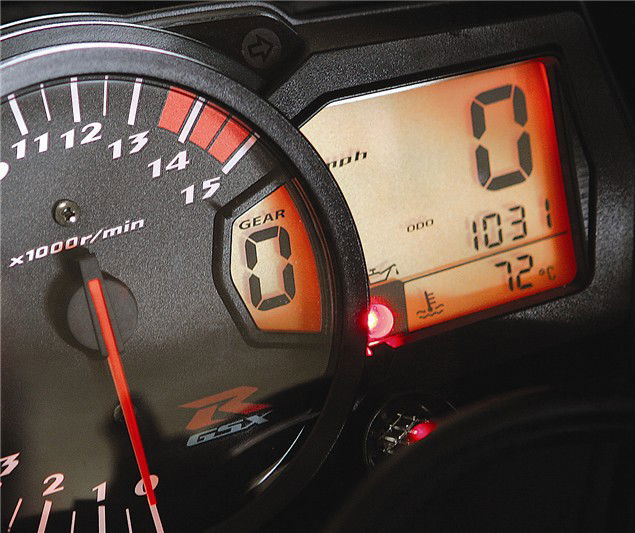
After all that we put the standard system back on, with the Power Commander mapped to suit. It's heavy and weird-looking, but the standard can's looks have grown on me. It is remarkable though just how much difference the PCIII can make to an otherwise standard bike. The graphs don't tell the story as the lines look near identical. The proof is in the riding. Throttle response is more precise and controllable, the engine feels a touch fresher and livelier and the transition from closed or trailing throttle in both hairpins and long, fast corners is smoother. It's also improved fuel economy in everyday riding by an average 2mpg or so up to 42mpg. Result! And a big thanks to Martin, Janice and Frank at Dynojet for letting me get in the way all day. And feeding me. Go to www.dynojet-uk.com for your nearest Dynojet centre.
Suspension next. The shock has been re-valved and re-sprung by suspension suspecialists K-Tech. For my 15 stones the standard rear spring is a little soft, especially if your tastes err towards sharp steering over stability, so K-Tech fitted a 9kg spring (8kg is standard) in stylish grey. Set to 12mm of static sag as recommended by them, the bike now sits slightly higher at the back with me on board and turns in tighter and quicker, although the trade off is a nonchalant head wagging every now and then when hard on the gas out of corners.
Feedback and control is improved, especially out of turns, and there's a subtlety to the damping that wasn't there before. It feels like familiar roads have been covered with a high quality carpet; bumps and imperfections are still there, but dealt with in a more sophisticated way. Lumps and potholes jar a little more due to the stiffer spring, but the improvement all-round is enlightening. It's like a getting a new pair of glasses without realising they were needed.
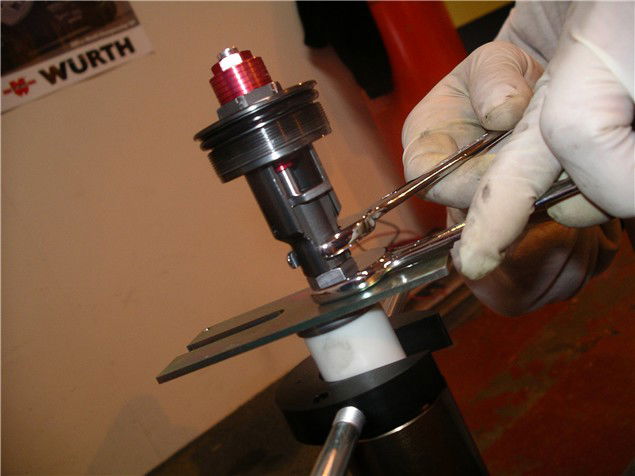
K-Tech can do the same for you. The GSX-R's conversion would cost £278.38, which gets you as good as an …hlins for half the price - less if you don't need a new spring. You'll have to remove the shock and send it to them (tip if you're taking the K5's out - unbolt the rectifier, then pull the shock out from above), so call first and they'll arrange a time when it can be turned around asap. Call (01530) 810625 or go to www.k-tech.uk.com
Tyres, then. The original rear BT014 was changed for a new one (the OE 'J' fitment) at 1888 miles in readiness for the International King of Bikes test back in the August issue. It was worn down to 2.8mm and had squared off a bit, which upset the steering noticeably. That rate of wear works out at 3200-odd miles down to the 1mm legal limit. At 4346 miles that rear and the original front were changed. The second rear had worn down to 1.5mm in 2458 miles (works out at 2800 miles down to the 1mm limit), but it had worked harder - lots of pillion work, a track day and 80 miles flat-out on a dyno. The front still had 2.9mm of tread left. Bridgestone's recommended pressures are 36f/42r road, 32f/32r track.
I like the OE Bridgestones but wanted to try Pirelli Diablos - not the grippier Corsas - next (pressures - 35f/39r road, 31f/29r track). The Diablos have a lighter feel at the bars but otherwise turn pretty much the same as the Bridgestones. They grip a bit better too and I preferred them on the track, but the trade-off is accelerated wear. Oh well.
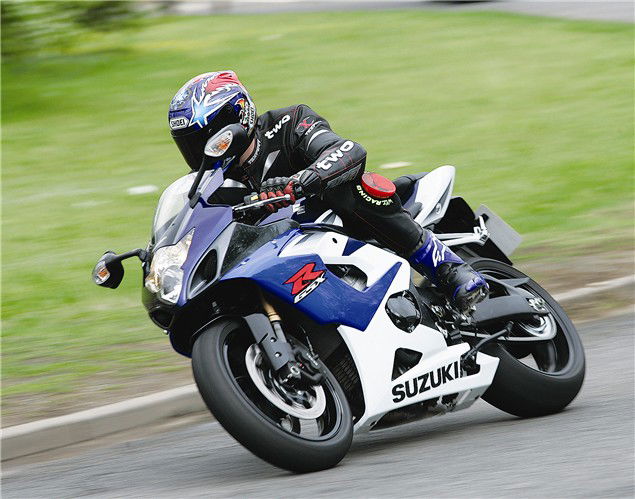
January 2006
THE LAST TIME I rode the GSX-R on track the limiting factor became the forks. The K-Tech shocked rear end was as good as perfect, but the front end couldn't cope with really heavy braking. I was on the Donington GP circuit (thanks to Track Attack, call 0871 2003010 to book some), so there was lots of that to be done. Hard on the brakes, the forks would bottom and the back end float clear of the ground and off on its own.
Even on the road, the forks would use all their travel without too much effort. After consultation with a few people, including K-Tech again (01530 810625), I decided to raise the fork oil level a bit to give more support when the forks are compressed towards the bottom of their stroke. The theory is that by raising the oil level you reduce the air gap above it. The more you compress air, the harder it becomes to compress, so by reducing the volume of air in the fork you get more resistance the further the fork compresses, without affecting the forks' feel further up the stroke.
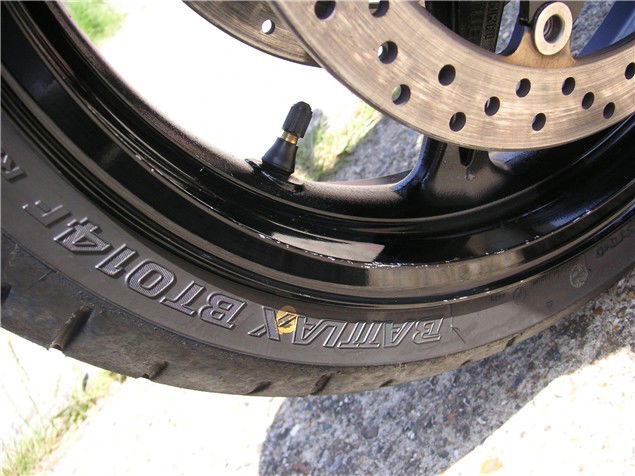
The mechanics of changing the oil level were covered in the December 2005 issue's DIY tip, and bear in mind it wasn't a five-minute job. Special tools were needed too, so you may want to get a dealer or suspension specialist to do the work. What we ended up with was a 96mm air gap, reduced from 106mm, using standard 5w fork oil. Not a big change, but I was taken aback by the difference.
At normal road speed the change was barely noticeable, like perhaps a half-turn increase in fork preload, but as the forks compressed they stiffened up further down the stroke and I couldn't get them to bottom. I was genuinely excited about trying them on track the next week, but sadly it wasn't to be (see below).
Other new stuff includes a double bubble screen from Skidmarx (£49.95, 01305 780808 or go to www.skidmarx.co.uk), which made things a lot better at speed although wind noise was up a dB or two. All round it's a big improvement, although the bottom of the screen is clear, not black, so you can see behind the clocks, which is a bit messy. I put some black tape over the inside of that bit to cover them up. Here's a fitting tip: remove the instrument cluster first (single allen bolt and a push-fit mounting lug) and disconnect the indicator wires behind before removing the mirrors.

Carbone Lorraine SBK-5 pads (£24.95 a pair, call PMM UK on 0845 6094949) also went in, as the OE ones were about two-thirds worn and suffered heat-induced fade last time I went on track. The SBK-5s bedded in suspiciously quickly - usually a sign of soft, fast-wearing pads - but Carbone Lorraine claims pad life equal to or better than OE, along with tons of grip and feel. I can vouch for the last two but pad life will go untested (again, see below).
To finish off, a few gripes. For all its good points the GSX-R suffers from a poor finish, something that more pernickety owners who'd just shelled out over £8500 could feel justified at being aggrieved by. The bodywork marks and scratches easily, and high-speed insect strikes to the front of the fairing leave bits of invertebrate antennae and elytra permanently embedded in the soft plastic. Also, quite early on in the bike's life the wheel paint started flaking off in places - and that's before the wheels had been off or the tyres removed.
Finally, the moan to end all moans: the GSX-R has been stolen, which made me very, very angry. I haven't lost out personally, since the bike wasn't mine to start with, and anyone suffering the loss of a bike they'd paid for has every right to be ten thousand times more annoyed than me. But I had done a lot to and with the Suzuki and had more things planned, including a trip abroad in my own time and at my own expense.
The bike was taken from the TWO offices in broad daylight by two very well organised and well prepared thieves who arrived two-up on an SV1000. I won't give more details now since the police are still looking into it, but there may be more to tell in the future. I doubt we'll see our GSX-R again, but if we can help stop the same thing happening to real, paying customers like yourselves, we will.
